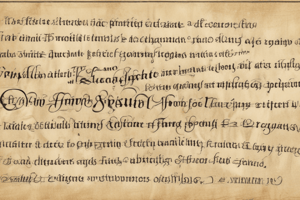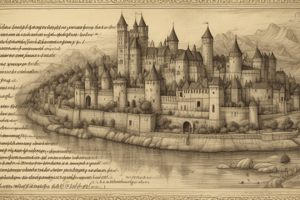Podcast
Questions and Answers
What is the Latin script?
What is the Latin script?
- A writing system based on the Greek alphabet used in ancient Greece
- A writing system based on the Cyrillic alphabet used in Eastern Europe
- A writing system based on the Chinese characters used in East Asia
- A writing system based on the Roman alphabet used in ancient Rome (correct)
Which writing system is the basis for the International Phonetic Alphabet?
Which writing system is the basis for the International Phonetic Alphabet?
- Katakana script
- Arabic script
- Latin script (correct)
- Cyrillic script
Which writing system has the largest number of alphabets?
Which writing system has the largest number of alphabets?
- Chinese characters
- Cyrillic script
- Latin script (correct)
- Arabic script
What is the Roman numeral system?
What is the Roman numeral system?
Which languages adopted the Latin alphabet during the Middle Ages?
Which languages adopted the Latin alphabet during the Middle Ages?
Which writing system was generally adopted by the speakers of East Slavic languages?
Which writing system was generally adopted by the speakers of East Slavic languages?
Why did the Romanians switch to the Latin alphabet in the late 19th century?
Why did the Romanians switch to the Latin alphabet in the late 19th century?
Which peoples had their writing systems replaced by the Latin-based Uniform Turkic alphabet in the 1930s?
Which peoples had their writing systems replaced by the Latin-based Uniform Turkic alphabet in the 1930s?
What is Romanization?
What is Romanization?
Flashcards are hidden until you start studying
Study Notes
Latin Script: A Writing System Based on the Alphabet Used by the Romans
-
The Latin script is an alphabetic writing system based on the classical Latin alphabet, derived from a form of the Greek alphabet used in the ancient Greek city of Cumae in southern Italy.
-
The Latin script is the basis of the International Phonetic Alphabet, and the 26 most widespread letters are the same letters as the English alphabet.
-
Latin script is the basis for the largest number of alphabets of any writing system and is the most widely adopted writing system in the world.
-
The script is either called Latin script or Roman script, in reference to its origin in ancient Rome.
-
The numeral system is called the Roman numeral system, and the collection of the elements is known as the Roman numerals.
-
The Latin alphabet spread, along with Latin, from the Italian Peninsula to the lands surrounding the Mediterranean Sea with the expansion of the Roman Empire.
-
With the spread of Western Christianity during the Middle Ages, the Latin alphabet was gradually adopted by the peoples of Northern Europe who spoke Celtic languages or Germanic languages, as well as by the speakers of several Uralic languages, most notably Hungarian, Finnish, and Estonian.
-
Since the 16th century, the Latin script was used for writing the West Slavic languages and several South Slavic languages while the speakers of East Slavic languages generally adopted Cyrillic along with Orthodox Christianity.
-
In the late 19th century, the Romanians switched to the Latin alphabet, which they had used until the Council of Florence in 1439, primarily because Romanian is a Romance language.
-
In the 20th century, most of the Turkic-speaking peoples of the former USSR had their writing systems replaced by the Latin-based Uniform Turkic alphabet in the 1930s.
-
In 2015, the government of Kazakhstan announced that a Kazakh Latin alphabet would replace the Kazakh Cyrillic alphabet as the official writing system for the Kazakh language by 2025.
-
In October 2019, the organization National Representational Organization for Inuit in Canada (ITK) announced that they will introduce a unified writing system for the Inuit languages in the country based on the Latin alphabet.
-
As of July 2020, 2.6 billion people (36% of the world population) use the Latin alphabet.Overview of Latin script letters, diacritics, ligatures, and collation
-
The Latin script is widely used around the world, and includes 26 letters in its basic form.
-
Various languages use additional letters, such as ñ in Spanish or ç in French, which are considered separate letters for collation purposes.
-
Diacritics, such as accents and umlauts, can modify the phonetic value of a letter and may indicate the start of a new syllable.
-
Ligatures are characters made up of two or more letters joined together, such as & or æ.
-
Digraphs and trigraphs are pairs or groups of letters that represent a single sound, such as ch or sch.
-
Capitalization rules vary by language and have changed over time.
-
Romanization is the process of transliterating or transcribing words from languages not written in the Latin script.
-
The African reference alphabet uses additional letters, such as ɓ and ƙ, to represent sounds not found in the basic Latin script.
-
The Turkish, Azerbaijani, and Kazakh alphabets use two forms of the letter I, dotted and dotless.
-
In Dutch, the ij digraph is often written as a ligature (ij) and is never capitalized as Ij.
-
The German language includes ligatures such as œ and trigraphs such as sch.
Studying That Suits You
Use AI to generate personalized quizzes and flashcards to suit your learning preferences.




